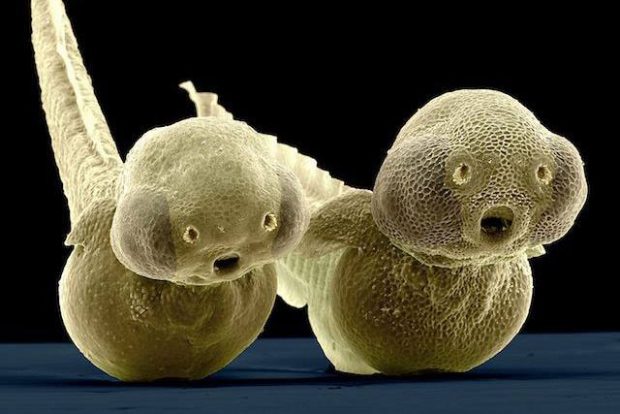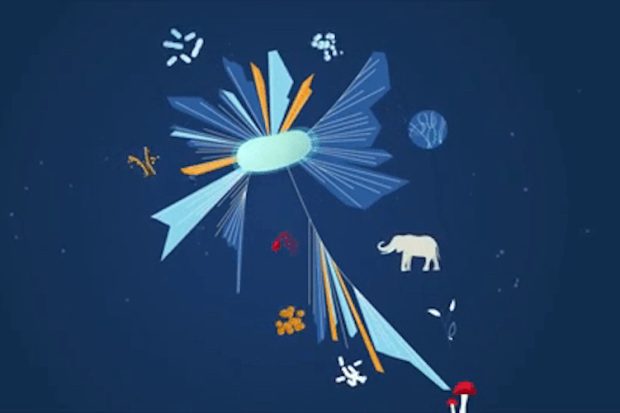DNA Topology
Biophysicist Maxim Frank-Kamenetskii on DNA supercoiling, topoisomerases, and enigmatic organisation of chromo...

In the picture, you can see the bioluminescent glow of plankton organisms. These could be copepods or jellyfish, but the most widespread are dinoflagellates. Dinoflagellates glow while moving in the water column and the glow is stronger when they experience mechanical impact or stress — for example when a boat or a predator comes around.
Generally, one could say that dinophytes feel rather comfortable in the water column — there is enough sun and food, nitrogen, phosphorus, and there are no substances that are harmful to them. The better the conditions, the brighter the glow of the organisms experiencing mechanical impact.
The chemistry of bioluminescence has been understood only recently, but today the ability of organisms to produce light is widely used in science. Japanese scientist Osama Shimomura received the Nobel Prize for his discovery of bioluminescence (in jellyfish) and GFP protein.

The protein binding substrate luciferin dissociates from the protein under external influence, and then an enzyme called luciferase acts upon it. Oxygen also takes part in this reaction, and the electrical impulse serves as a signal for its initiation. As a result, the cell membrane potential changes and the cell starts to glow.
Knowing how this process occurs allows to recreate it in organisms that do not normally have this ability, such as E.Coli, and conduct various tests on them. With the help of luminescence, molecular biologists can track the expression (i.e. the process by which the information encoded in the DNA is converted into protein or RNA) of genes in bacteria.
It is harder to understand why planktonic organisms need this ability. There are several hypotheses, but none of them is supported by enough evidence. Some believe that dinoflagellates use light to scare off predators that intend to eat them. According to another version, this glow is aimed at attracting the predators that hunt the enemies of dinoflagellates.
Bioluminescence of dinoflagellates may be beautiful, but it may also be a signal of danger. Many of the species in this group are toxic. If dinoflagellates reproduce rapidly, they may cause so-called ‘red tides’. During this period all the animals (molluscs, fish, etc.) that feed on dinoflagellates also become toxic due to the accumulation of high amounts of toxins from dinoflagellates. It is dangerous to eat such sea animals because the toxins that are contained in them may have various unpleasant effects: some merely irritate the bowel and cause food poisoning, whereas others, being neurotoxins, may even have an effect on memory.
Some species, such as the sea sparkle (Noctiluca scintillans) are not as toxic, but may have other unpleasant effects.

The sea sparkle belongs to the group of non-photosynthesising dinoflagellates since they are carnivores. As such, they excrete ammonia as a by-product of their metabolism, and ammonia is harmful to other organisms. If the numbers of sea sparkles are high, this may have unpleasant consequences – ammonia ions dissolve in water and may cause blossoming of the other algae.
Water samples are usually taken in all the habitats of dinoflagellates. When resting in these areas, it is highly advisable to keep track of the current information on water quality. If you do, nocturnal bioluminescence will just be a spectacular phenomenon and will not become a problem.
It is also important to note that dinophytes can be in symbiosis with corals, which is an important component of coral formation. Without dinophytes, coral reefs would not be possible. This is why not only do they create miracles on the sea surface but also those in the depths.

Biophysicist Maxim Frank-Kamenetskii on DNA supercoiling, topoisomerases, and enigmatic organisation of chromo...

Geneticist Steve Jones on obesity, biology of Homos and genetics' influence on people's lives

Philosopher Jonathan Birch on animal welfare, indicators of sentience and how to determine whether a crab feel...